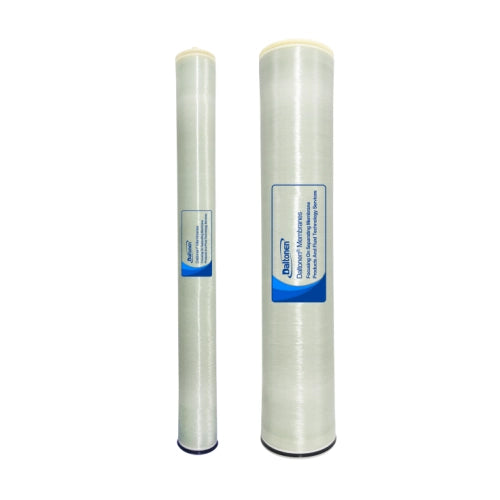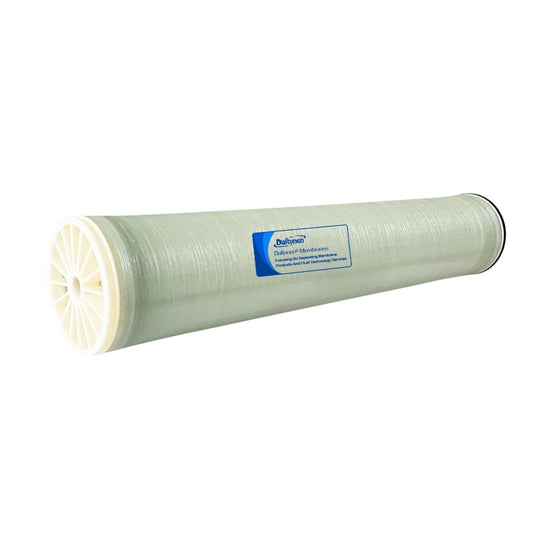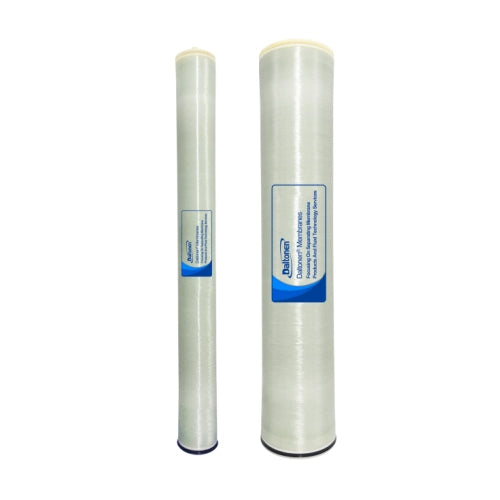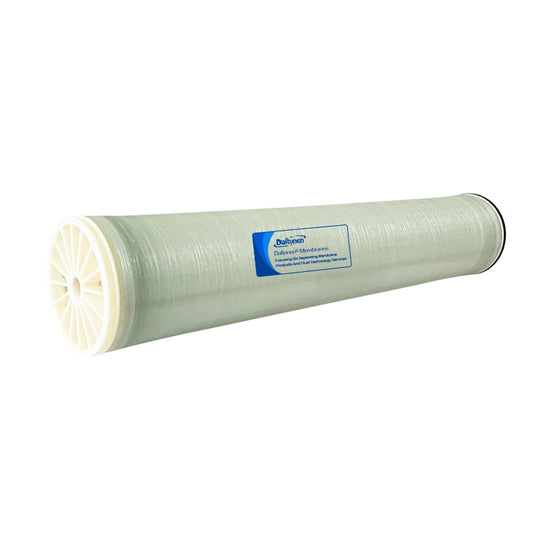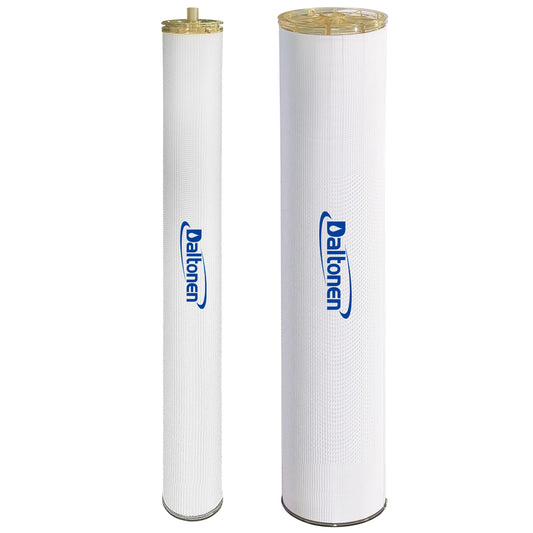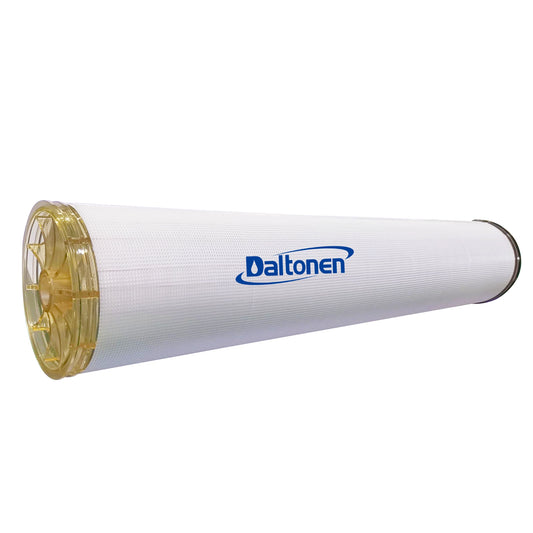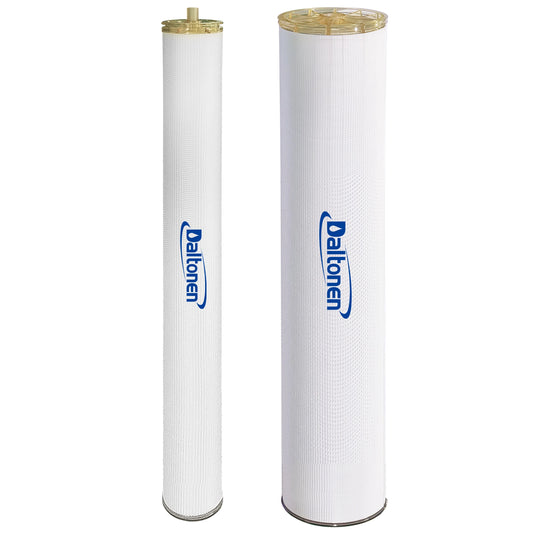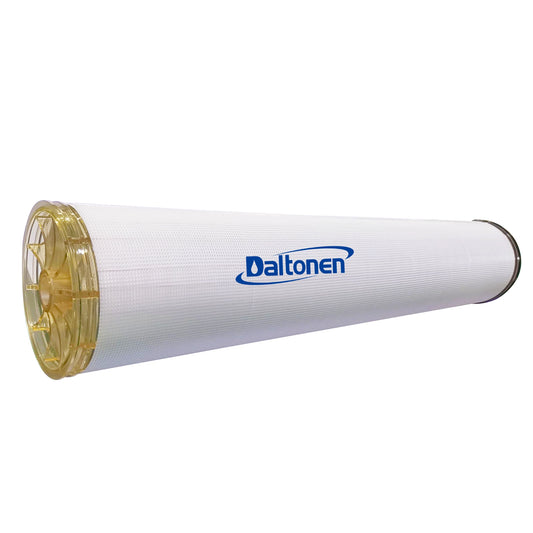Characteristics of Low-Pressure RO Reverse Osmosis Membranes
Characteristics of Low-Pressure RO Reverse Osmosis Membranes
1. Definition and Principle of Low-Pressure RO Reverse Osmosis Membranes
1.1 Basic Concept
Low-pressure RO reverse osmosis membranes are highly efficient membrane materials used in water treatment. The core principle is to utilize the characteristics of semipermeable membranes, where pressure is applied on both sides of the membrane, allowing water molecules to pass through while retaining solutes and other particles. Compared to traditional high-pressure reverse osmosis membranes, low-pressure RO membranes can achieve effective separation processes at lower operating pressures (typically between 0.5~1.6 MPa), thereby significantly reducing energy consumption. These membranes usually have high water flux, high salt rejection rate, good chemical stability, and high mechanical strength, making them more energy-efficient and efficient in water treatment.
1.2 Working Principle
The working principle of low-pressure RO membranes is based on reverse osmosis technology, which is the process of solvent (usually water) passing through a semipermeable membrane under pressure. In this process, solutes (such as salts) are blocked on one side of the membrane. Specifically, when pressure is applied to the feed solution on one side of the membrane, and the pressure exceeds its osmotic pressure, the solvent will permeate in the reverse direction against natural osmosis, thus obtaining the permeated solvent on the low-pressure side of the membrane, i.e., the permeate, and the concentrated solution on the high-pressure side, i.e., the concentrate. The pore size of low-pressure RO membranes is very small, approximately 0.1 nanometers, so only water molecules can pass through, while other substances such as ions, molecules, and particles are retained. In applications such as wastewater treatment or pure water preparation, low-pressure RO membranes can effectively remove dissolved salts, colloids, microorganisms, organic matter, etc., from water, thereby purifying and concentrating the feed solution.

2. Characteristics of Low-Pressure RO Reverse Osmosis Membranes
2.1 Low-Energy Operation
Low-pressure RO reverse osmosis membranes exhibit significant low-energy characteristics in the water treatment process. Since they can achieve effective separation processes at lower operating pressures (typically between 0.5~1.6 MPa), they greatly reduce the energy consumption required for operation compared to traditional high-pressure reverse osmosis membranes. For example, when treating brackish water, surface water, groundwater, tap water, and other water sources with a salt content of up to 2000 ppm, low-pressure RO membranes can effectively perform desalination while saving a considerable amount of energy. According to relevant data, water treatment systems using low-pressure RO membranes can reduce energy consumption by about 30% to 50% compared to high-pressure systems. This is particularly significant for long-term operating water treatment facilities, as it can significantly reduce operating costs, especially against the backdrop of rising energy prices, making low-pressure RO membranes more competitive among various water treatment technologies.
2.2 High Water Flux
Low-pressure RO reverse osmosis membranes typically have a high water flux, which means they can produce a large amount of purified water in a unit of time. This feature allows low-pressure RO membranes to more efficiently meet water demand when treating large-scale water sources. For example, in industrial water use scenarios such as the production of high-purity water in electronics and pharmaceutical industries, as well as wastewater treatment in the food industry and beverage water production, low-pressure RO membranes can quickly convert a large amount of raw water into the required pure water or treated water, improving production efficiency. Additionally, in home reverse osmosis water purifiers, low-pressure RO membranes can ensure a sufficient water output to provide ample drinking water for households. According to relevant research and actual application data, the water flux of low-pressure RO membranes can generally reach 10 to 20 liters per square meter of membrane area per hour, or even higher. This value may vary under different water quality and operating conditions, but overall, it is superior to traditional high-pressure reverse osmosis membranes, providing users with a more efficient and economical water treatment solution.
2.3 High Desalination Rate
Despite the relatively low operating pressure, low-pressure RO reverse osmosis membranes can still maintain a high desalination rate. When treating low-salinity, low-hardness water sources, the desalination rate of low-pressure RO membranes can usually reach 95% to 99%, effectively removing dissolved salts, heavy metal ions, organic matter, and other impurities from water, thereby ensuring the purity of the effluent water quality. This high desalination rate allows low-pressure RO membranes to meet strict water quality requirements in various water treatment applications. For example, in the field of drinking water purification, low-pressure RO membranes can remove harmful substances such as residual chlorine, heavy metals, and microorganisms from tap water, providing safe and healthy drinking water for people. In the pharmaceutical industry, low-pressure RO membranes are used to prepare process water with high purity requirements, and their high desalination rate ensures the purity of the water quality, meeting strict pharmacopoeia standards and GMP requirements. Moreover, low-pressure RO membranes also play an important role in agricultural irrigation. By removing salts and harmful substances from water, they generate water quality suitable for crop irrigation, which is conducive to the sustainable development of agriculture.
3. Application Fields of Low-Pressure RO Reverse Osmosis Membranes
3.1 Drinking Water Purification
Low-pressure RO reverse osmosis membranes play a vital role in the field of drinking water purification. In homes, offices, and communities, low-pressure RO membranes are widely used in direct drinking water machines and home water purifiers. They can effectively remove harmful substances such as residual chlorine, heavy metals, organic matter, and microorganisms from tap water, providing safe and healthy drinking water. For example, according to relevant research, the content of heavy metals in tap water purified by low-pressure RO membranes can be reduced by more than 90%, the removal rate of residual chlorine can reach about 95%, and the removal rate of microorganisms is close to 100%, significantly improving the quality of drinking water. In addition, the low-energy characteristic of low-pressure RO membranes reduces the operating cost of the equipment, and also makes the equipment more quiet and compact, more suitable for home use environments, providing people with a more convenient and economical solution for drinking water purification.
3.2 Food and Beverage Industry
In the process of food processing and beverage production, low-pressure RO reverse osmosis membranes are used to prepare pure water or ultrapure water as production raw water or cleaning water. Their energy-saving characteristics help enterprises reduce operating costs, and the stable water quality ensures the quality and taste of the products. For example, in beverage production, water treated by low-pressure RO membranes is used as raw material, which can ensure the consistency and quality stability of the beverages, and at the same time reduce the product disqualification rate caused by water quality problems. According to industry data, the stability of water quality prepared by low-pressure RO membranes can be improved by 30% to 40%, and the product qualification rate can be increased by 15% to 20%. In addition, for juice, tea drinks and other liquid foods that are consumed directly, low-pressure RO membranes can also remove harmful components such as heavy metals and organic pollutants from the raw water, improving product quality and ensuring the health and safety of consumers.
3.3 Agricultural Irrigation
In modern agriculture, low-pressure RO reverse osmosis membranes are used to treat groundwater, surface water, or reclaimed water to generate water quality suitable for crop irrigation. The high water flux provided by low-pressure membranes at lower energy consumption can meet the irrigation needs of large areas of farmland, while reducing the potential impact of salts and harmful substances on soil and crops, which is conducive to the sustainable development of agriculture. For example, in some saline-alkali lands or areas with poor water quality, the use of low-pressure RO membranes to treat irrigation water can reduce the salt content in the water to a level suitable for crop growth, improving the yield and quality of crops. According to agricultural research data, the use of irrigation water treated by low-pressure RO membranes can increase the yield of crops by 20% to 30%, and at the same time reduce soil degradation caused by soil salinization, playing a positive role in the protection of agricultural ecological environment.

4. Advantages of Low-Pressure RO Reverse Osmosis Membranes
4.1 Energy Conservation and Consumption Reduction
Low-pressure RO reverse osmosis membranes exhibit significant characteristics of energy conservation and consumption reduction in the water treatment process. Since they can achieve effective separation processes at lower operating pressures (typically between 0.5~1.6 MPa), they greatly reduce the energy consumption required for operation compared to traditional high-pressure reverse osmosis membranes. For example, when treating brackish water, surface water, groundwater, tap water, and other water sources with a salt content of up to 2000 ppm, low-pressure RO membranes can effectively perform desalination while saving a considerable amount of energy. According to relevant data, water treatment systems using low-pressure RO membranes can reduce energy consumption by about 30% to 50% compared to high-pressure systems. This is particularly significant for long-term operating water treatment facilities, as it can significantly reduce operating costs, especially against the backdrop of rising energy prices, making low-pressure RO membranes more competitive among various water treatment technologies.
4.2 Equipment Simplification and Cost Control
The application of low-pressure RO reverse osmosis membranes helps to simplify water treatment equipment and effectively control costs. Due to the lower operating pressure of low-pressure RO membranes, there is no need to equip high-pressure pumps and high-strength pressure vessels, thereby reducing the complexity of the equipment and the initial investment cost. For example, the operating pressure of conventional reverse osmosis membranes is 1.3 to 1.5 MPa, while the operating pressure of ultra-low-pressure reverse osmosis membranes is about 0.8 MPa or even lower. This makes the overall structure of the equipment simpler, reducing the volume and weight of the equipment, making it easier to install and maintain. In addition, the low-energy characteristic of low-pressure RO membranes also means that a large amount of electricity costs can be saved in the long-term operation, further reducing operating costs. It is estimated that for large RO systems, choosing low-pressure RO membranes can basically offset more than 70% of the annual depreciation cost of the membrane, and the saving effect is more significant.
4.3 Technological Innovation and Market Expansion
The technological innovation of low-pressure RO reverse osmosis membranes continuously promotes the improvement of their performance and the expansion of their application fields. With the progress of membrane material science and the optimization of membrane-making processes, the performance indicators of low-pressure RO membranes such as water flux, desalination rate, and anti-pollution ability have been significantly improved. For example, new types of low-pressure RO membranes use advanced nanomaterials and composite technologies. Not only do they improve the hydrophilicity of the membrane and reduce membrane surface pollution, but they also enhance the mechanical strength and chemical stability of the membrane, extending the service life of the membrane. These technological innovations enable low-pressure RO membranes to maintain high performance when treating more complex water quality and higher concentrations of pollutants, thereby expanding their applications in high-end fields such as industrial wastewater treatment, seawater desalination, and biomedicine. At the same time, the market for low-pressure RO membranes is also continuously expanding. It has been widely used in the domestic market and has gradually occupied a place in the international market, providing more choices and solutions for the development of the water treatment industry.
5. Maintenance and Care of Low-Pressure RO Reverse Osmosis Membranes
5.1 Regular Cleaning
Regular cleaning of low-pressure RO reverse osmosis membranes is crucial for maintaining their performance. It is generally recommended to clean the membranes every 3 to 12 months, depending on the water quality of the feed water and the degree of membrane pollution. The cleaning process includes the following steps:
(1).Low-Pressure Rinsing: Use reverse osmosis product water or pretreatment effluent (without special chemicals) to rinse the membrane system at a low pressure and low flow rate (about 20-40 psi). Discharge for a few minutes to clean the inside.
(2).Preparation of Cleaning Solution: According to the recommendations of the membrane element manufacturer, prepare the cleaning solution with reverse osmosis product water. Accurately weigh the chemicals and mix them evenly. Check the pH value, temperature (suggestion≥25℃) and chemical content of the cleaning solution.
(3).Low-Pressure Low-Flow Input of Cleaning Solution and Circulation: Input the cleaning solution to the system at a flow rate of 1/3 of the normal cleaning flow and a pressure of 20-40 psi. Discard the initial return water to prevent the cleaning solution from being diluted. Let the cleaning solution circulate in the pipeline for 5-10 minutes, and observe the turbidity and pH value of the return flow. If it becomes significantly turbid or the pH value changes by more than 0.5, add an appropriate amount of chemicals or reprepare the cleaning solution and repeat the operation.
(4).Soaking and Intermittent Circulation: Stop the circulation of the cleaning pump to prevent the cleaning solution from flowing out of the pressure vessel. You can close the relevant valves. Depending on the degree of component pollution, soak all the membrane components in the cleaning solution for about 1 hour or longer (10 to 15 hours or overnight). During this period, you can intermittently start the circulation pump to maintain a constant temperature of the cleaning solution (25 to 30℃).
(5).High-Flow Circulation: Increase the flow rate of the cleaning solution to 1.5 times the normal cleaning flow for cleaning, and circulate for 30-60 minutes. The pressure at this time should not be too high, limited to the pressure at which the system has no or only a small amount of product water, and pay attention that the pressure difference of the membrane element and the pressure difference of the pressure vessel should not exceed the limit value.
(6).Rinsing: First, rinse the system with product water (the lowest rinsing temperature is 20℃) for about 5 minutes, and then rinse the system with pretreatment qualified product water for 20-30 minutes to completely flush out the cleaning solution without residue. Start the system operation and check the cleaning effect, and the produced water should be discarded. If the machine is to be stopped and not used, the components should be preserved according to the relevant methods.
5.2 Water Quality Monitoring
Water quality monitoring is a key link to ensure the effective operation of the low-pressure RO reverse osmosis membrane system. The following water quality parameters of the raw water and product water should be regularly monitored:
(1).Total Dissolved Solids (TDS): Measure the conductivity of the feed water and product water with a conductivity meter or TDS meter to calculate the rejection rate, in order to evaluate the desalination performance of the membrane. Generally speaking, the desalination rate of low-pressure RO membranes should be maintained at around 95% to 99%.
(2).pH Value: Monitor the pH value of the feed water and product water to ensure that it is within the tolerance range of the membrane (usually 2 to 11). Changes in pH value may affect the performance and service life of the membrane. For example, the charge degree of some ions is different at different pH values, which in turn affects their removal rate.
(3).Turbidity: The turbidity of the feed water should be less than 2NTU to reduce the risk of membrane pollution. High-turbidity feed water may lead to an increase in membrane surface deposits, reducing the water flux.
(4).Residual Chlorine: The concentration of free residual chlorine in the feed water should be less than 0.1ppm, because residual chlorine will cause oxidative damage to the membrane material and shorten the service life of the membrane. In the pretreatment stage, it is usually necessary to add a reducing agent (such as sodium bisulfite) to remove residual chlorine.
(5).Microbial Content: Regularly detect the microbial content of the feed water and product water to ensure that the system does not become a breeding ground for microorganisms. Although reverse osmosis membranes have a high removal rate for viruses, bacteria, and other microorganisms, microorganisms may still reproduce on the product water side under conditions such as system shutdown or improper maintenance.
5.3 System Operational Stability
Maintaining the operational stability of the low-pressure RO reverse osmosis membrane system is crucial for extending the service life of the membrane and ensuring the quality of the effluent water. The following are some key measures for operational stability:
(1).Stable Operating Pressure: The operating pressure of low-pressure RO membranes is usually between 0.5 to 1.6 MPa, and pressure fluctuations should be avoided. Excessive pressure may cause physical damage to the membrane, while too low pressure will affect the water flux and desalination rate. By precisely controlling the operation of the high-pressure pump and adjusting the opening degree of the regulating valve, a stable operating pressure can be maintained.
(2).Suitable Operating Temperature: Temperature has a significant impact on the performance of RO membranes. Generally speaking, for every 1℃ increase in water temperature, the diffusion coefficient of water molecules increases by 2% to 3%, and the water production also increases accordingly. However, high temperatures may also cause the membrane material to age and the chemical stability to decrease. Therefore, the feed water temperature should be controlled within the range of 5 to 45℃ to ensure the performance and service life of the membrane. In practical applications, a heater or cooler can be used to adjust the feed water temperature to keep it within the optimal operating temperature range.
(3).Reasonable Recovery Rate: The recovery rate is the ratio of the water production to the feed water volume. A reasonable recovery rate helps to balance the system's water production efficiency and the risk of membrane pollution. An excessively high recovery rate may lead to intensified concentration polarization on the membrane surface, increasing the possibility of scaling and pollution; while an excessively low recovery rate will waste water resources. Generally, the recovery rate of the low-pressure RO membrane system should be controlled at around 70% to 75%, and the specific value should be optimized according to the feed water quality and system design.
(4).Regular Inspection and Maintenance of Key Components: Regularly inspect the operating conditions of key components such as high-pressure pumps, pressure vessels, valves, and pipelines, and promptly identify and solve potential problems. For example, check whether the impeller and sealing parts of the high-pressure pump are worn or damaged, whether the pressure vessel has leakage or corrosion, and whether the valves can be opened and closed flexibly and reliably. For components that have faults or are aging, they should be replaced in time to ensure the stable operation of the system.
(5).Optimization of Pretreatment System: Strengthen the operation and maintenance of the pretreatment system to ensure that the water quality entering the RO membrane meets the requirements. The pretreatment system usually includes multi-media filters, activated carbon filters, softeners, security filters, etc., which can effectively remove suspended solids, colloids, organic matter, heavy metal ions, and other pollutants from the feed water, reducing the risk of membrane pollution. According to the changes in feed water quality, adjust the pretreatment process and chemical dosage in time to improve the pretreatment effect.

6. Development Trends of Low-Pressure RO Reverse Osmosis Membranes
6.1 Technological Innovation Directions
The technological innovation directions of low-pressure RO reverse osmosis membranes are mainly focused on the following aspects:
(1).Improving Membrane Performance: By improving membrane materials and membrane-making processes, further improve the water flux, desalination rate, and anti-pollution ability of low-pressure RO membranes. For example, develop new types of nanocomposite materials and add them to the membrane materials. This can enhance the hydrophilicity of the membrane, reduce membrane surface pollution, and at the same time improve the mechanical strength and chemical stability of the membrane, extending the service life of the membrane. According to relevant research, low-pressure RO membranes modified by nanotechnology can increase the water flux by 20% to 30%, the desalination rate can reach more than 99%, and the anti-pollution ability is significantly enhanced, which can effectively cope with more complex water quality and higher concentrations of pollutants.
(2).Reducing Energy Consumption: Continuing to reduce the operating pressure and energy consumption of low-pressure RO membranes is an important direction of technological innovation. On the one hand, by optimizing the structural design of the membrane, such as using thinner separation layers and more reasonable supporting layer structures, the operating pressure of the membrane can be reduced while ensuring the separation effect; on the other hand, develop new types of energy-saving membrane components and systems, such as using energy recovery devices to recover the energy of high-pressure concentrated water, further reducing the energy consumption of the system. It is estimated that through technological innovation, the energy consumption of low-pressure RO membrane systems can be reduced by another 20% to 30% on the existing basis, which has important economic and environmental significance for large-scale water treatment projects.
(3).Intelligent and Automated: With the development of the Internet of Things, big data, and artificial intelligence technologies, low-pressure RO reverse osmosis membrane systems will develop towards intelligent and automated directions. By installing various sensors in the membrane system to monitor the water quality of the feed water and product water, the pressure and flow of the membrane in real time, and transmit the data to the control center. Utilize big data analysis and artificial intelligence algorithms to diagnose and optimize the system in real time, realize automatic cleaning, automatic adjustment of operating parameters and other functions, improve the operating efficiency and stability of the system, reduce the cost of manual operation and maintenance difficulty. For example, the intelligent control system can automatically adjust the cleaning cycle and cleaning method according to the degree of membrane pollution, extend the service life of the membrane; it can also automatically adjust the operating pressure and recovery rate according to the changes in the water quality of the feed water, to ensure the best operating state of the system.
(4).Multifunctional Integration: Developing low-pressure RO reverse osmosis membrane products with multifunctional integration is also one of the future development trends. For example, integrate pretreatment functions with RO membranes to form integrated membrane components, which can simplify the water treatment process, reduce the equipment footprint and investment cost. In addition, special-function RO membranes can also be developed, such as antibacterial, deodorizing, removing specific pollutants, etc., to meet the personalized water quality requirements of different users. For example, RO membranes added with antibacterial agents can effectively inhibit the proliferation of microorganisms on the membrane surface, improve the sanitary safety of the product water; RO membranes with deodorizing functions can remove odorous substances from water, improve the taste and quality of the product water.
6.2 Market Expansion Potential
The market expansion potential of low-pressure RO reverse osmosis membranes is huge, mainly reflected in the following aspects:
(1).Deepening of Drinking Water Purification Market: With the improvement of people's living standards and the enhancement of health awareness, the requirements for drinking water quality are getting higher and higher. Low-pressure RO reverse osmosis membranes have been widely used in drinking water purification equipment in homes, offices, schools, hospitals and other places, and the market demand continues to grow. Especially in some areas with poor water quality, such as areas with high groundwater hardness and high salt content, as well as areas affected by industrial pollution, low-pressure RO membrane purification equipment has become an important means to ensure the safety of residents' drinking water. According to market research data, in the next few years, the global drinking water purification market's demand for low-pressure RO membranes will grow at a rate of 10% to 15% per year, and the market prospect is broad.
(2).Expansion of Industrial Water Treatment Market: In industrial fields such as electronics, pharmaceuticals, chemicals, and power, the demand for high-purity process water is increasing. Low-pressure RO reverse osmosis membranes can effectively remove dissolved salts, organic matter, microorganisms and other impurities from water, and prepare high-purity water that meets the requirements of industrial production. Therefore, they have a broad application prospect in the industrial water treatment market. For example, in the electronics industry, low-pressure RO membranes can be used for pure water preparation in the manufacturing of semiconductor chips and liquid crystal displays, ensuring the quality and performance of the products; in the pharmaceutical industry, low-pressure RO membranes can be used for the preparation of injection water and purified water, meeting strict pharmacopoeia standards. With the continuous development and upgrading of industry, the share of low-pressure RO membranes in the industrial water treatment market is expected to further expand.
(3).Rise of Seawater Desalination Market: The global water shortage problem is becoming more and more serious, and seawater desalination has become an important way to solve the water shortage problem in coastal areas and islands. Low-pressure RO reverse osmosis membranes have significant advantages in the field of seawater desalination, and their low-energy and high-desalination rate characteristics make them one of the preferred technologies for seawater desalination. In recent years, with the continuous progress of seawater desalination technology and the reduction of costs, the seawater desalination market has shown a rapid growth trend. According to statistics from the International Desalination Association, the global seawater desalination market size has grown nearly three times in the past decade, and it is expected to maintain a high growth rate in the next few years. Low-pressure RO membranes, as the core components of seawater desalination, will usher in huge market opportunities.
(4).Growth of Wastewater Treatment and Reuse Market: Under the increasingly strict environmental policies, wastewater treatment and reuse have become an inevitable choice for industrial enterprises and social development. Low-pressure RO reverse osmosis membranes can effectively remove pollutants from wastewater and achieve in-depth treatment and reuse of wastewater, which is of great significance for alleviating water shortage and reducing environmental pollution. For example, in high-pollution industries such as printing and dyeing, electroplating, and papermaking, low-pressure RO membranes can be used for wastewater treatment and reuse, improving the utilization rate of water resources, reducing the water use cost and sewage discharge cost of enterprises. According to relevant research predictions, in the next few years, the global wastewater treatment and reuse market's demand for low-pressure RO membranes will grow at a rate of 20% to 25% per year, and the market potential is huge.
(5).Development of Emerging Markets: In addition to the above traditional application fields, low-pressure RO reverse osmosis membranes also show a good application prospect in some emerging markets. For example, in the field of agricultural irrigation, low-pressure RO membranes can be used to treat groundwater or reclaimed water with high salt content, providing suitable irrigation water for crops, improving the efficiency of agricultural water use and crop yield; in the field of aerospace, low-pressure RO membranes can be used for the purification of drinking water in aircraft and the water cycle treatment in the life support system of astronauts; in the field of marine engineering, low-pressure RO membranes can be used for the fresh water supply of offshore platforms and the development and utilization of sea water resources. The development of these emerging markets will further expand the application scope and market space of low-pressure RO reverse osmosis membranes.
7. Conclusion
Low-pressure RO reverse osmosis membranes, as an efficient water treatment technology, have shown significant advantages and broad application prospects in many fields. Their low-energy operation characteristics make them more economical in today's rising energy costs and can significantly reduce operating costs for users and enterprises. The high water flux ensures the efficiency when treating large-scale water sources, whether in industrial production or household use, providing sufficient purified water. At the same time, the high desalination rate ensures the purity of the effluent water quality, meeting the strict water quality requirements from drinking water purification to medicine, food and other industries.
The application fields of low-pressure RO reverse osmosis membranes are continuously expanding, playing an important role from traditional drinking water purification and food and beverage industries to modern agricultural irrigation, medical industry and light industry wastewater treatment and reuse, etc. Their important role in improving the efficiency of water resource utilization, ensuring water quality safety, and promoting the dual benefits of environmental protection and economy makes them an important force in building a green, economical and intelligent water resource management system.
In terms of maintenance and care, measures such as regular cleaning, water quality monitoring and maintaining the stability of system operation can effectively extend the service life of low-pressure RO reverse osmosis membranes and ensure their long-term stable operation. Technological innovation directions such as improving membrane performance, reducing energy consumption, intelligent and automated, and multifunctional integration will further promote the development of low-pressure RO reverse osmosis membrane technology and enhance its competitiveness in the market.
The market expansion potential is huge, not only in the traditional drinking water purification and industrial water treatment markets with continuous growth in demand, but also in the seawater desalination, wastewater treatment and reuse, and some emerging markets such as agricultural irrigation, aerospace, marine engineering, etc., showing a good application prospect. With the continuous progress of technology and the continuous growth of market demand, the application fields of low-pressure RO reverse osmosis membranes will be further expanded, making a greater contribution to the sustainable use of global water resources and environmental protection.
